Brother 1034DX, 3534DT, SB3734T, ST4031HD Operation Manual
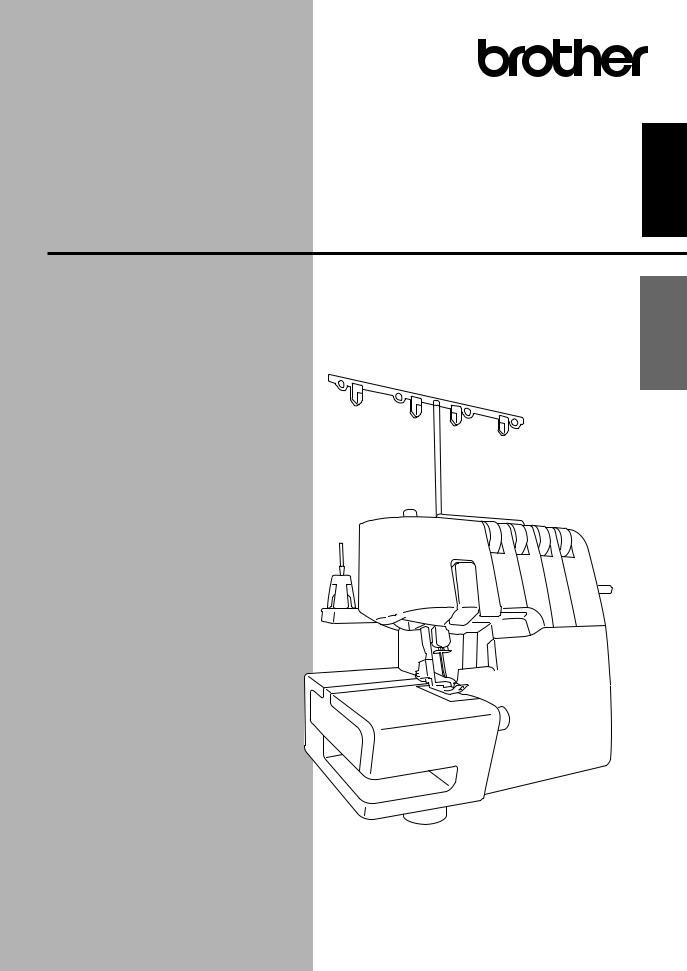
Operation Manual
Compact Overlock Machine
Product Code: 884-B02 / B03
Manual de instrucciones
Máquina Compacta Overlock
Código de producto: 884-B02 / B03
Be sure to read this document before using the machine.
We recommend that you keep this document nearby for future reference.
Lea este documento antes de utilizar la máquina.
Recomendamos que tenga este documento a mano por si necesita consultarlo más adelante.
English
Español

IMPORTANT SAFETY INSTRUCTIONS
When using the sewing machine, basic safety precautions should always be followed, including the following. Read all instructions before using.
 DANGER
DANGER
To reduce the risk of electric shock.
The sewing machine should never be left unattended when plugged in. Always unplug this sewing machine from the electrical outlet immediately after using and before cleaning.
 WARNING
WARNING
To reduce the risk of burns, fire, electric shock, or injury to persons.
1.Do not allow to be used as a toy. Close attention is necessary when the sewing machine is used by or near children.
2.Use this sewing machine only for its intended use as described in this manual. Use only accessories recommended by the manufacturer as contained in this manual.
3.Never operate this sewing machine if it has a damaged cord or plug, if it is not working properly, if it has been dropped or damaged, or dropped into water. Return the sewing machine to the nearest authorized dealer or service center for examination, repair, electrical or mechanical adjustment.
4.Never operate the sewing machine with any air openings blocked. Keep ventilation openings of the sewing machine and foot controller free from the accumulation of lint, dust, and loose cloth.
5.Never drop or insert any object into any openings.
6.Do not use outdoors.
7.Do not operate where aerosol (spray) products are being used or where oxygen is being administered.
8.To disconnect, turn the main switch to the symbol "O" position which represents off, then remove plug from outlet.
9.Do not unplug by pulling on cord. To unplug, grasp the plug, not the cord.
10.Keep fi ngers away from all moving parts. Special care is required around the sewing machine needle.
11.Always use the proper needle plate. The wrong plate can cause the needle to break.
12.Do not use bent needles.
13.Do not pull or push fabric while stitching. It may defl ect the needle causing it to break.
14.Switch the sewing machine to the symbol "O" position when making any adjustments in the needle area, such as threading needle, changing needle, or changing presser foot, etc.
15.Always unplug the sewing machine from the electrical outlet when removing covers, lubricating, or when making any other user servicing adjustments mentioned in the instruction manual.
16.Electrical Hazards:
-This machine should be connected to an AC power source within the range indicated on the rating label. Do not connect it to a DC power source or inverter. If you are not sure what kind of power source you have, contact a qualifi ed electrician.
-This machine is approved for use in the country of purchase only.
17.This sewing machine is not intended for use by young children or infi rm persons without supervision.
18.Young children should be supervised to ensure that they do not play with this sewing machine.
19.Do not disassenble the machine.
20.If the LED light unit (light-emitting diode) is damaged, it must be replaced by authorized dealer.
 CAUTION
CAUTION
To use the machine safely
1.(For U.S.A. only)
This appliance has a polarized plug (one blade wider than the other) to reduce the risk of electric shock, this plug is intended to fi t in a polarized outlet only one way.
If the plug does not fi t fully in the outlet, reverse the plug. If it still does not fi t, contact a qualifi ed electrician to install the proper outlet.
Do not modify the plug in any way.
2.Make sure you watch the needles carefully while you are sewing. Do not touch the hand wheel, needles, knives, or other moving parts.
3.Turn off the main power and unplug the cord in the following circumstances:
-When you have stopped using the machine
-When you are replacing or removing the needle or any other part
-If there is a power failure while you are using the machine
-If you are checking or cleaning the machine
-Leaving the machine unattended
4.Do not store anything on the foot controller.
5.Fully plug the machine directly into the wall. Do not use extension cords.
6.If water is dropped on the machine, unplug the machine immediately, and contact your local authorized dealer.
7.Do not put furniture on the cord.
8.Do not bend the cord, or pull on the cord to unplug.
9.Do not touch the cord with wet hands.
10.Place the machine near to the wall outlet.
11.Do not place the machine on an unstable surface.
12.Do not put on the soft cover.
13.If you notice any abnormal sound or condition, consult your local authorized dealer.
To give your machine a longer life
1.Do not store this machine in direct sunlight or in high humidity conditions. Do not use or store the machine near a heater, iron, halogen lamp or other hot object.
2.Use only mild soaps or detergents to clean the case. Benzene, thinner, and scouring powders can damage the case and machine, and should never be used.
3.Do not drop or hit the machine.
4.Always consult this manual before you replace or fi t the presser foot, needle, or any other parts to make sure you fi t them correctly.
To repair or adjust the machine
If the machine breaks down or needs adjustment, fi rst follow the troubleshooting table to inspect and
adjust the machine yourself. If the problem persists, consult your local authorized dealer.

SAVE THESE INSTRUCTIONS
This machine is intended for household use.
FOR USERS IN COUNTRIES EXCEPT EUROPEAN COUNTRIES
This appliance is not intended for use by persons (including children) with reduced physical, sensory or mental capabilities, or lack of experience and knowledge, unless they have been given supervision or instruction concerning use of the appliance by a person responsible for their safety. Children should be supervised to ensure that they do not play with the appliance.
FOR USERS IN EUROPEAN COUNTRIES
This appliance can be used by children aged from 8 years and above and persons with reduced physical, sensory or mental capabilities or lack of experience and knowledge if they have been given supervision or instruction concerning use of the appliance in a safe way and understand the hazards involved. Children shall not play with the appliance. Cleaning and user maintenance shall not be made by children without supervision.
 CAUTION
CAUTION
When leaving this sewing machine unattended, the main power and light switch of the machine must be switched off or the plug must be removed from the socket-outlet.
When servicing the sewing machine, or when removing covers, the machine or the electrical set must be disconnected from the supply by removing the plug from the socket-outlet.
FOR USERS IN THE UK, EIRE,
MALTA AND CYPRUS ONLY
IMPORTANT
- In the event of replacing the plug fuse, use a fuse approved by ASTA to BS 1362, i.e. carrying the |
mark, |
rating as marked on plug. |
|
-Always replace the fuse cover. Never use plugs with the fuse cover omitted.
-If the available electrical outlet is not suitable for the plug supplied with this equipment, you should contact your authorized dealer to obtain the correct lead.
English
1
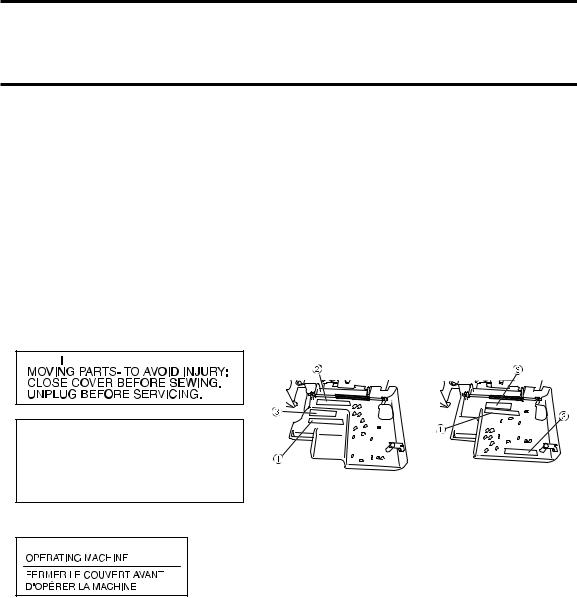
CONGRATULATIONS ON CHOOSING THIS COMPACT OVERLOCK MACHINE
Your machine is a high quality, easy-to-use product. To fully enjoy all the features, we suggest that you study this booklet.
If you need more information regarding the use of your machine, your nearest authorized dealer is always happy to be of service.
Enjoy yourself!
 CAUTION
CAUTION
When threading or replacing needle, the main power and light switch of the machine must be switched off or the plug must be removed from the socket-outlet.
When the machine is not in use, it is recommended that the electric supply plug is disconnected from the wall socket to avoid any possible hazards.
Notes on the motor
-The maximum operating speed of this sewing machine is 1,300 stitches per minute, which is quite fast compared to the normal operating speed of 300 to 800 stitches per minute for the ordinary sewing machine.
-The bearings in the motor are made of a special sintered, oil-impregnated alloy mounted in oilsoaked felt to withstand long hours of continuous operation.
-Continuous operation of the sewing machine can cause heat to build in the motor area, but not enough to adversely affect its performance.
It is important to keep fabric and paper away from the air openings on the back and sides of the machine so air can get to these openings.
-When the motor is running, sparks can be seen through the air openings in the motor bracket on the side opposite the hand wheel. These sparks are produced by the carbon brushes and the commutator, and are part of the machines normal operation.
WARNING LABELS (for complying with UL and CSA requirements)
The following warning labels are on the machine.
Be sure to observe the precautions described in the labels.
Caution (U.S.A. and CANADA only)
1


2AVERTISSEMENT:
PARTIES EN MOUVEMENT. POUR ÉVITER TOUTE BLESSURE: FERMER LE CAPOT AVANT DE COUDRE.
DÉBRANCHER AVANT ENTRETIEN.
Face plate sticker (U.S.A. and CANADA only)
3 




Label locations
[Product code: 884-B02] |
[Product code: 884-B03] |
2

Contents |
|
Chapter 1: Names of parts and their functions ................................................................... |
4 |
Accessories........................................................................................................................ |
5 |
Powering the machine........................................................................................................ |
6 |
Turning direction of hand wheel ......................................................................................... |
6 |
Opening/ Closing front cover.............................................................................................. |
6 |
Attaching/ Removing presser foot ...................................................................................... |
6 |
Trim trap ............................................................................................................................. |
7 |
Free-arm sewing (removing bed extension) ....................................................................... |
7 |
Retracting knife .................................................................................................................. |
8 |
Stitch length........................................................................................................................ |
8 |
Stitch width......................................................................................................................... |
8 |
Differential feed .................................................................................................................. |
9 |
Adjusting the presser foot pressure.................................................................................... |
9 |
Tension adjustment dial...................................................................................................... |
10 |
Chart of thread tension adjustment, Two needle (Four thread) .......................................... |
11 |
Chart of thread tension adjustment, One needle (Three thread) ....................................... |
12 |
Needle................................................................................................................................ |
13 |
Removing/ Installing the needle ......................................................................................... |
13 |
Chapter 2 : Preparation before threading............................................................................. |
14 |
Thread tree......................................................................................................................... |
14 |
How to use the thread spool cap........................................................................................ |
14 |
How to use the thread net .................................................................................................. |
14 |
Before threading................................................................................................................. |
14 |
Chapter 3: Threading.............................................................................................................. |
15 |
Threading the lower looper................................................................................................. |
15 |
Threading the upper looper................................................................................................ |
17 |
Threading the right needle ................................................................................................. |
18 |
Threading the left needle.................................................................................................... |
18 |
Chapter 4: Sewing materials, threads and needles comparison chart.............................. |
19 |
Chapter 5: Sewing .................................................................................................................. |
20 |
Stitch selection ................................................................................................................... |
20 |
Test sewing......................................................................................................................... |
20 |
Chaining-off........................................................................................................................ |
21 |
To start sewing ................................................................................................................... |
21 |
To remove work .................................................................................................................. |
21 |
To secure chain .................................................................................................................. |
22 |
If threads break during sewing ........................................................................................... |
23 |
To sew fi ne materials.......................................................................................................... |
23 |
Narrow overlock/ Rolled hemming stitch ............................................................................ |
23 |
Chart of narrow overlock/ rolled hemming stitch ................................................................ |
25 |
Chapter 6: Troubleshooting ................................................................................................... |
26 |
Chapter 7: Maintenance ......................................................................................................... |
27 |
Cleaning ............................................................................................................................. |
27 |
Oiling ................................................................................................................................. |
27 |
Chapter 8: Introduction of optional feet ............................................................................... |
28 |
Blind stitch foot ................................................................................................................... |
28 |
Taping foot.......................................................................................................................... |
30 |
Pearl sequence foot............................................................................................................ |
31 |
Piping foot .......................................................................................................................... |
32 |
Gatheing foot...................................................................................................................... |
33 |
Specifications ......................................................................................................................... |
34 |
Setting record ........................................................................................................................ |
71 |
English
3
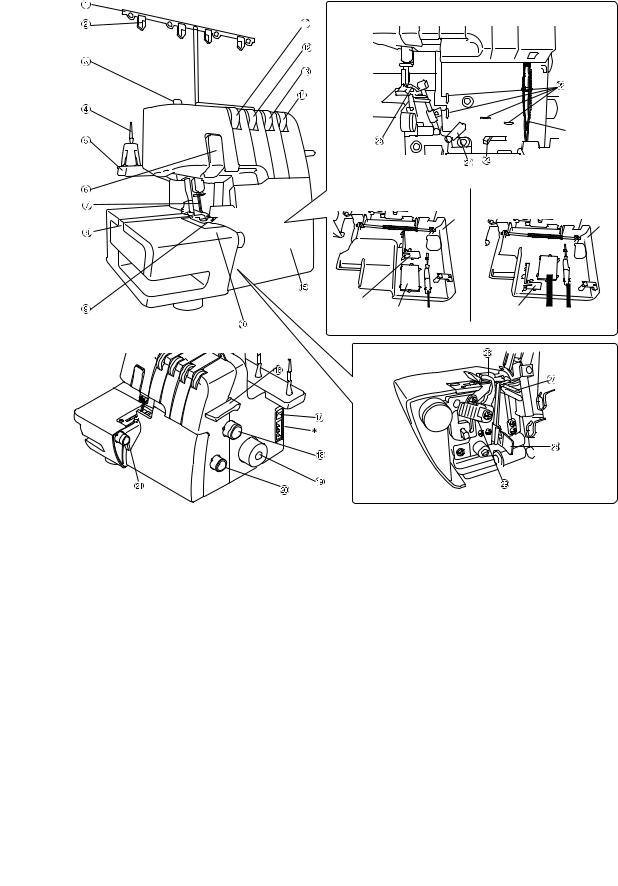
CHAPTER 1
NAMES OF PARTS AND THEIR FUNCTIONS
Inside of the front cover
<C>
[Product code: 884-B02] |
[Product code: 884-B03] |
t
t
<B>
<A> <D> |
<B> <A> <D> |
1Thread tree
2Thread plate
3Presser foot pressure adjustment screw
4Spool pin
5Spool support
6Thread take-up cover
7Needles
8Bed extension
9Presser foot
0 Material plate cover
ALeft needle thread tension dial
BRight needle thread tension dial
CUpper looper thread tension dial
DLower looper thread tension dial
EFront cover
FPresser foot lifting lever
GMain power and light switch
HStitch length adjustment dial
4
* The product code is shown on the machine rating plate.
IHand wheel
JDifferential feed ratio adjustment dial
KStitch width dial
Inside of the front cover
LThread guide
MLower looper threading lever
NThread take up for loopers
OUpper looper
PUpper knife
QLower looper
RStitch fi nger
SKnife lever
tFront cover compartment
You can hold the included accessories and the removed stitch finger in this front cover compartment. <A>: Needle set, <B>: Stitch finger (when removed, see CHAPTER 5 "Narrow overlock/ Rolled hemming stitch"), <C>: Tweezers, <D>: Hexagonal driver
* Air openings (on the side and back)
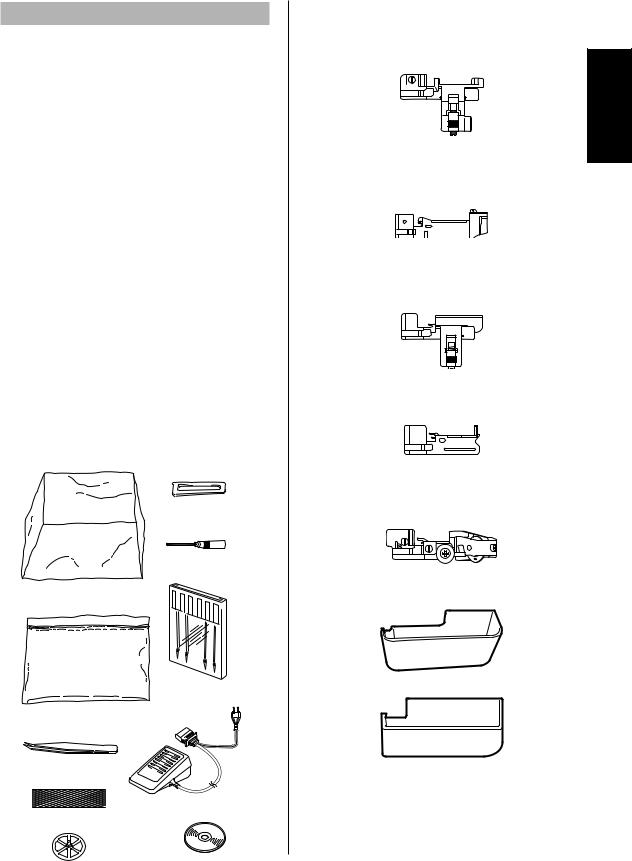
Accessories
Included accessory
1Soft cover: X77871000
2Accessory bag: 122991052
3Tweezers: XB1618001
4Thread net (4): X75904000
5Thread spool cap (4): X77260000
6Cleaning brush: X75906001
7Hexagonal driver: XB0393001
8Needle set (130/705H): XB2772001 #80: 2 pcs., #90: 2 pcs.
9Foot controller:
XC7359021 (120V Area)
XC7438421 (230V Area)
XC7456521 (U.K.)
XD0112121 (Argentina)
XD0852121 (Korea)
XD0105021 (China)
XE0629001 (Australia, New Zealand)
XF2826001 (Brazil 127V)
XE4302201 (Brazil 220V)
0 Instruction DVD: XB2791001 (NTSC)
XB2776001 (PAL)
1 |
6 |
|
|
7
8
2
9
3
4
0
5
Optional accessory
For further information about the following items, see CHAPTER 8.
A Blind stitch foot: X76590002
English
B Gathering foot:
SA213 (U.S.A., CANADA)
X77459001 (OTHERS)
LG
C Pearl sequence foot:
SA211 (U.S.A., CANADA)
X76670002 (OTHERS)
LS
D Piping foot:
SA210 (U.S.A., CANADA)
XB0241101 (OTHERS)
LP
E Taping (Elastic) foot:
SA212 (U.S.A., CANADA)
X76663001 (OTHERS)
F Trim trap: |
884-B02 |
Trim trap: XB2793001 for product code 884-B03
*The product code is shown on the machine rating plate.
5
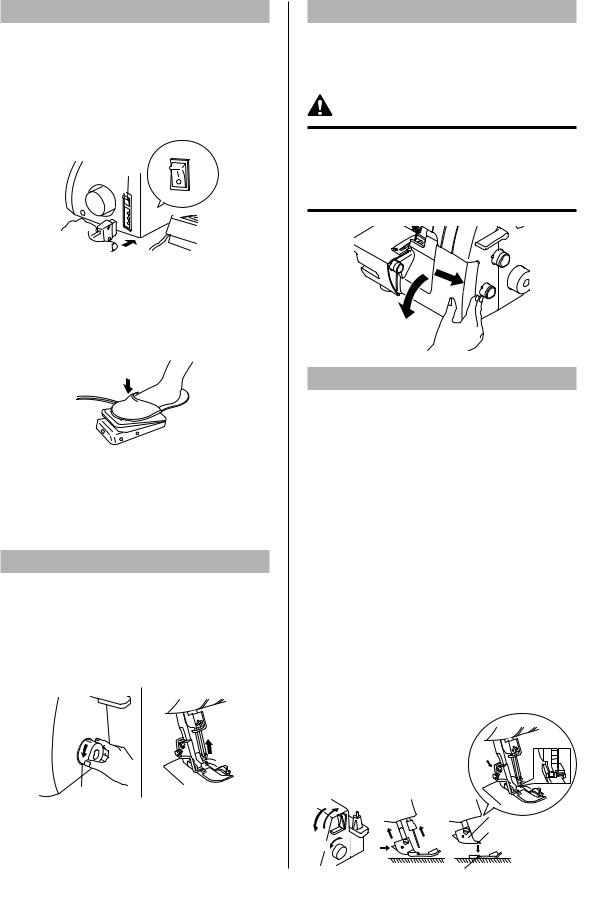
Powering the machine
Turning on the machine
1.Insert the three-pin plug into the socket on the bottom right side of the machine. Insert the power supply plug into a power outlet.
2.Turn the main power and light switch <A> to "I" mark (to "O" mark to turn off).
<A>
Operation
When the foot controller is pressed lightly, the machine runs at a low speed. As the foot controller is pressed further, the machine will increase speed. When the foot controller is released, the machine stops.
NOTE (For U.S.A. only):
Foot controller: Model KD-1902
This foot controller can be used on the machine with product code 884-B02 and 884-B03.
*The product code is shown on the machine rating plate.
Turning direction of hand wheel
The hand wheel <A> turns in a counterclockwise direction (direction of arrow). This is the same direction as an ordinary home sewing machine. The needles move to their highest positions by turning the hand wheel so that the mark <B>
on the hand wheel is aligned to the line on the machine.
<B>

<A>
6
Opening/ Closing front cover
It is necessary to open the front cover when threading this machine. Slide it to the right 1 and open 2, or close it and slide it to the left.
 CAUTION
CAUTION
For your safety, make sure that the front cover is closed when operating the machine.
Always turn off the machine before opening the front cover.
1
2
Attaching/ Removing presser foot
1.Turn off the main power and light switch or disconnect the electric supply plug.
2.Raise the presser foot lever. 1
3.Turn the hand wheel 2 so that the mark on the hand wheel is aligned to the line on the machine. (See CHAPTER1 "Turning direction of hand wheel".)
4.Push the button on the presser foot holder and the standard presser foot will be released. 3 4
5.Raise the presser foot farther by pushing the presser foot lever upward. Then remove the presser foot and store it in a safe location.
6.Again, raise the presser foot farther by pushing the presser foot lever upward. Then place the presser foot just under the presser foot holder <A> so that the groove in the bottom of the presser foot holder <B> is aligned and catches the bar on the top of the foot <C>. Then lower the presser foot lever to attatch the foot, pushing the button on the presser foot.
4
|
|
|
<A> |
|
1 |
2 |
|
<B> |
|
1 |
2 |
|||
|
|
|||
|
|
|
||
|
3 |
|
4 |
<C>

Trim trap
The optional trim trap <A> holds the trimmed fabric and thread produced when sewing.
<B>
<A>
To install:
Insert the trim trap <A> until it contacts the front cover.
NOTE:
Be sure to position the positioning guide <B> to the one on the machine.
To remove:
Slowly pull out the trim trap.
NOTE:
The optional trim trap can also be used as the foot controller holder.
 CAUTION
CAUTION
Always remove the foot controller from the trim trap when carrying the machine.
Free-arm sewing (removing bed extension)
Free-arm sewing enables tubular pieces to be sewn more easily.
1. Remove the
English
NOTE:
Be careful not to lose the removed bed extension.
2. Position the fabric, and start sewing. (See
7
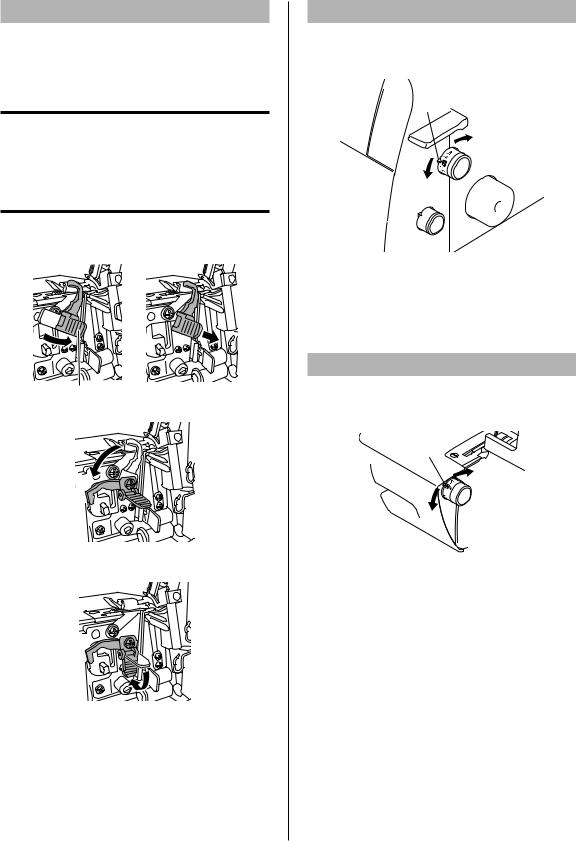
Retracting knife
To sew without cutting the fabric edge, you need to retract the knife as follows.
 CAUTION
CAUTION
Do not touch the knife.
Move the knife lever only while the needle is at its lowest point.
Be sure to unplug the power supply cord from the wall outlet before retracting the knife.
1.Pull up the knife lever <A>, then pull it to the right.
<A>
2. Bring down the knife.
3.Retract the knife completely, then take your hand off from the lever.
Stitch length
The normal stitch length setting is 3 mm. To change the stitch length, turn the stitch length adjustment dial on the right side of the body.
<A>
1
1 Shorten the stitch length to a minimum of 2 mm (5/64 inch).
2 Lengthen the stitch to a maximum of 4 mm (5/32 inch).
<A> Selection mark
Stitch width
The normal stitch width setting for regular overlock stitch is 5mm (13/64 inch). To change the stitch width, turn the stitch width adjustment dial.
<A>
 2
2
1 Increase the width to a maximum of 7 mm (9/32 inch).
2 Reduce the stitch width to a minimum of 5 mm (3/16 inch).
<A> Selection mark
8
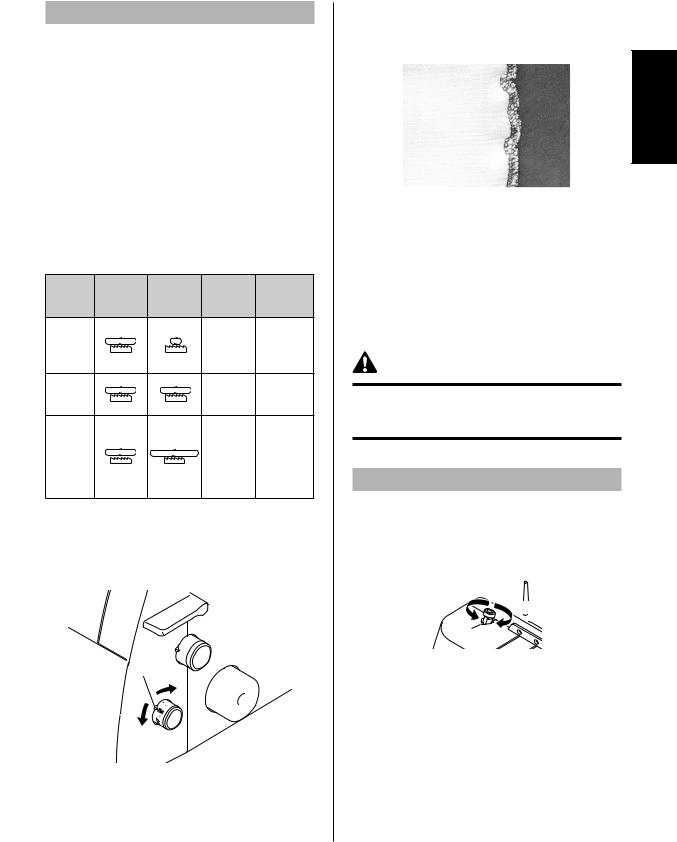
Differential feed
This serger is equipped with two sets of feed dogs under the presser foot to move the fabric through the machine. The differential feed controls the movement of both the front and the rear feed dogs. When set at 1, the feed dogs are moving at the same speed (ratio of 1). When the differential feed ratio is set at less than 1, the front feed dogs move slower than the rear feed dogs, stretching the fabric as it is sewn. This is effective on lightweight fabric that may pucker. When the differential feed ratio is set at greater than 1, the front feed dogs move faster than the rear feed dogs, gathering
the fabric as it is sewn. This function assists in removing the rippling when serging stretch fabrics.
Differential feed adjustment
Feed |
Main |
Differential Effect |
Application |
ratio |
feed |
feed (front) |
|
|
(rear) |
|
|
|
|
Material is |
Prevents thin |
0.7 - 1.0 |
|
pulled tight. materials |
|
|
|
from |
|
|
|
|
|
|
|
|
puckering |
|
|
Without |
Normal |
1.0 |
|
differential |
sewing |
|
|
feed. |
|
|
|
Material is |
Prevents |
|
|
gathered |
stretch |
1.0 - 2.0 |
|
or pushed |
materials |
|
together. |
from |
|
|
|
||
|
|
|
stretching or |
|
|
|
puckering |
The normal setting is 1.0 on the differential feed adjustment dial.
To adjust the diffrerential feed, turn the dial on the right bottom of the body.
<A>
1
2
1 Less than 1.0 2 Greater than 1.0 <A> Selection mark
An example
When stretch material is sewn without using the differential feed, the edge will be wavy.
To get smooth fi nish, adjust the feed ratio from 1.0 toward 2.0.
(The feed ratio required depends on the elasticity of the material.)
The more elastic the material, the further toward 2.0 the differential feed ratio should be set. Test sew with a scrap of the fabric to fi nd the correct adjustment.
 CAUTION
CAUTION
When sewing thick non-stretchable material such as denim, do not use the differential feed as it may damage the fabric.
Adjusting the presser foot pressure
Turn the pressure adjustment screw on the top left of the machine. You can adjust by referring the value on the screw.
The normal setting is "2".
1
2 
<A>
1 Less pressure
2 More pressure <A> Selection mark
English
9
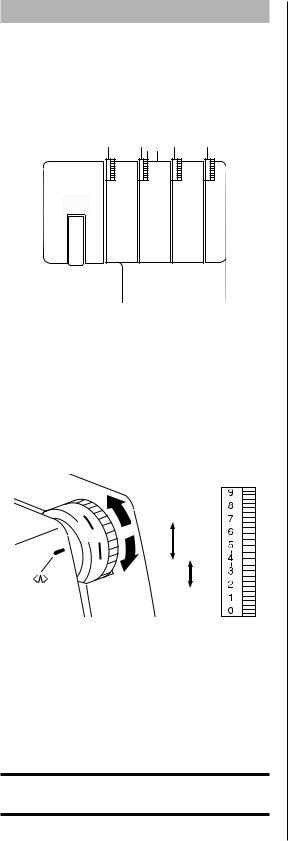
Tension adjustment dial
There is a thread tension dial for each needle thread, the lower looper thread and the upper looper thread. The correct thread tension may vary according to the type and thickness of the fabric and the type of thread used. Thread tension adjustments may be necessary for any change in sewing materials.
1 2 3 4
1Yellow marked tension disc is for left needle.
2 Pink marked tension disc is for right needle.
3 Green marked tension disc is for upper looper.
4 Blue marked tension disc is for lower looper.
Tension control
Sewing is possible at position "4" for most circumstances. (Standard: SPAN 60/3Z)
If the stitch quality is insuffi cient, select a different tension setting.
5
4
3 

<A> Tension selection mark
1 For heavy tension: 4 to 7
2 For light tension: 4 to 2
3 For medium tension: 5 to 3
If you cannot fi nd the correct tension, refer to the charts on following pages.
 CAUTION
CAUTION
Make sure that the thread is properly seated in the tension discs.
10
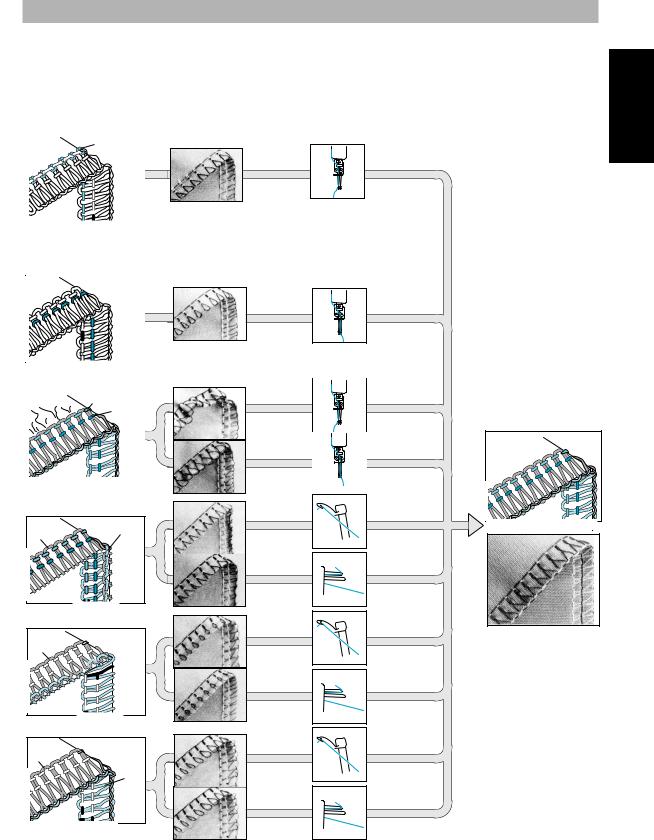
Chart of thread tension adjustment, Two needle (Four thread)
A:Reverse
B:Surface
C:Left needle thread
D:Right needle thread
E:Upper looper thread
F:Lower looper thread
A C
 B
B
A  D
D
B
A |
C |
|
D |
|
B |
A |
E |
F |
B |
A
F



 E
E
B
A |
F |
E |
B |
Left needle thread is loose.
Right needle thread is loose.
Left needle thread is tight.
Right needle thread is tight.
Upper looper thread is tight.
Lower looper thread is loose.
Upper looper thread is loose.
Lower looper thread is tight.
Upper looper thread is loose.
Lower looper thread is loose.
Tighten left needle thread. (yellow)
Tighten right needle thread. (pink)
Loosen left needle thread. (yellow)
Loosen right needle thread (pink)
Loosen upper looper thread (green)
Tighten lower looper thread (blue)
Tighten upper looper thread (green)
Loosen lower looper thread (blue)
Tighten upper looper thread (green)
Tighten lower looper thread (blue)
When you adjust the thread tension, do it in the following order:
(1)Left needle thread
(2)Right needle thread
(3)Upper looper thread
(4)Lower looper thread
This is the easiest way to obtain the correct thread tension.
English
11
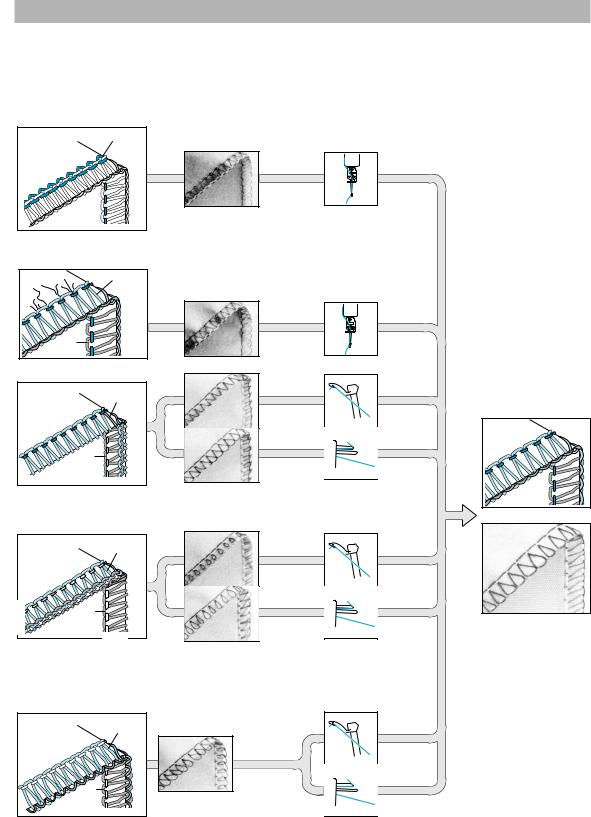
Chart of thread tension adjustment, One needle (Three thread)
A:Reverse
B:Surface
C:Needle thread
D:Upper looper thread
E:Lower looper thread
|
|
C |
A |
|
|
|
|
Needle thread |
|
|
is loose. |
|
|
B |
C |
|
E |
A |
|
|
|
D |
Needle thread |
|
is tight. |
|
|
B |
|
|
|
|
|
|
E |
|
|
Upper looper |
A |
|
thread is tight. |
|
|
D |
B |
|
Lower looper |
|
thread is |
|
|
|
|
|
|
loose. |
|
|
E |
A |
|
Upper looper |
|
|
thread is |
|
|
loose. |
|
|
D |
B |
|
Lower looper |
|
thread is tight. |
|
|
|
|
E |
|
Upper looper |
A |
thread is loose. |
|
Lower looper |
D |
thread is loose. |
B |
|
Tighten needle thread.
(yellow or pink)
Loosen needle thread. (yellow or pink)
Loosen upper looper thread (green)
Tighten lower looper thread (blue)
Tighten upper looper thread (green)
Loosen lower looper thread (blue)
Tighten upper looper thread (green)
Tighten lower looper thread (blue)
When you adjust the thread tension, do it in the following order:
(1)Needle thread
(2)Upper looper thread
(3)Lower looper thread
This is the easiest way to obtain the correct thread tension.
12
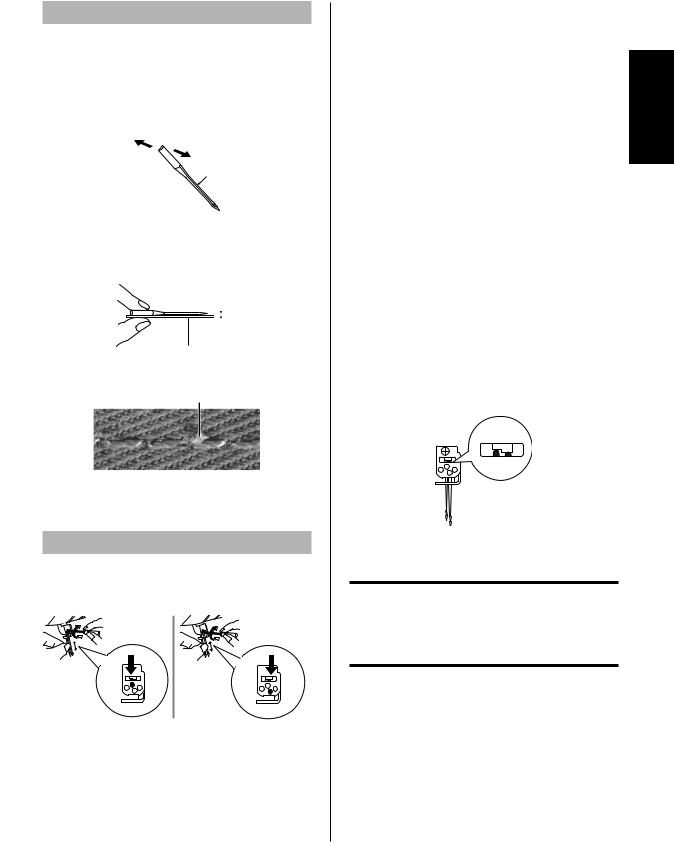
Needle
This machine uses a standard home sewing machine needle.
The recommended needle is 130/705H (#80 or #90).
Needle description
1 Back (fl at side) Groove
1 |
2 |
|
|
|
3 |
How to check the needle
4Flat surface
5Place the needle on its fl at side and check to see if the space is parallel.

 5
5
4
NOTE:
Countermeasures for material breakage <A>.
<A>
It can reduce the occurrence of material breakage by using 130/705H SUK (#90) BALL POINT.
Removing/ Installing the needle
<A> Removing/ installing the left needle <B> Removing/ installing the right needle
<A> |
<B> |
1 |
1 |
1 Tighten 2 Loosen
To remove:
1.Turn the main power and light switch to the OFF position.
2.Turn the hand wheel so that the mark on
the hand wheel is aligned to the line on the |
|
|
machine. (See CHAPTER 1 "Turning direction |
English |
|
of hand wheel".) |
||
|
||
3. Loosen the corresponding needle set screw |
|
|
with turning the included hexagonal driver |
|
|
toward 2 in the fi gure, and remove the needle. |
|
To install:
1.Turn the main power and light switch to the OFF position.
2.Turn the hand wheel so that the line on the hand wheel is aligned to the line on the machine.
3.Hold the needle with its fl at side away from you and insert it up as far as it will go.
4.Tighten the needle set screw securely with turning the included hexagonal driver toward 1 in the fi gure.
NOTE:
Make sure to insert the needles all the way.
If the needles have been inserted correctly, the right needle should be set slightly lower than the left one.
 CAUTION
CAUTION
Always be sure to turn off the power before removing/ inserting the needle.
Do not drop the needle and needle set screw in the machine, otherwise it may be damaged.
13
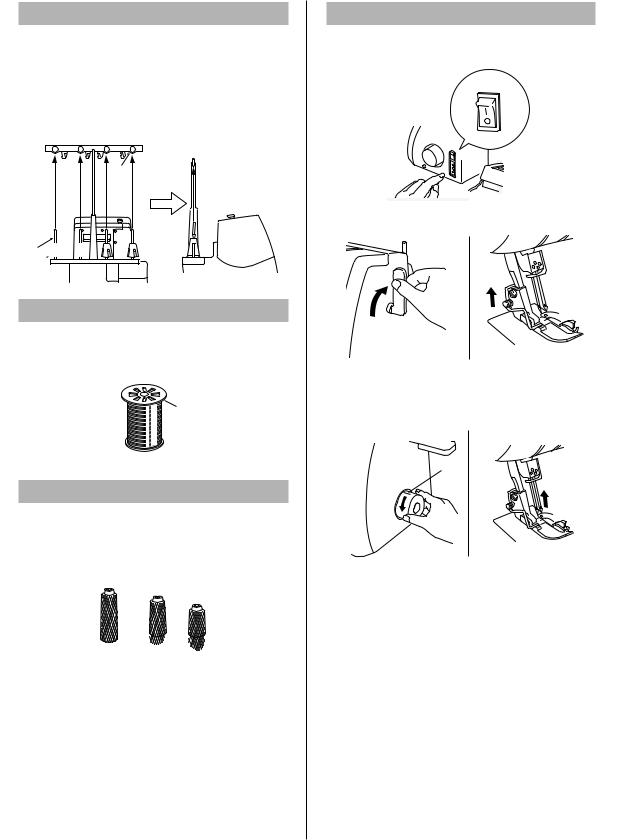
CHAPTER 2
PREPARATION BEFORE THREADING
Thread tree
Raise the telescoping thread tree to its highest position. Make sure that the thread holders are in alignment above the spool pins as illustrated below.
1 Thread holder on thread tree
2 Spool pin
3 Correct position
3
1
2 



How to use the thread spool cap
When using sewing thread spools, the thread spool cap should be used as illustrated below. Make sure
that the spool notch is |
bottom. |
|
|
1 Thread spool cap
How to use the thread net
If you are sewing with loosely spun nylon thread, we recommend that you cover the spool with the net supplied to prevent the thread from slipping off the spool.
Adapt the net to the shape of the spool.
Before threading
1.Turn off the main power and light switch for safety.
2. Raise the presser foot using presser foot lever.
3.Turn the hand wheel so that the mark on the hand wheel <A> is aligned to the line <B> on the machine. (See CHAPTER 1 "Turning direction of hand wheel".)
<A>
<B>

14
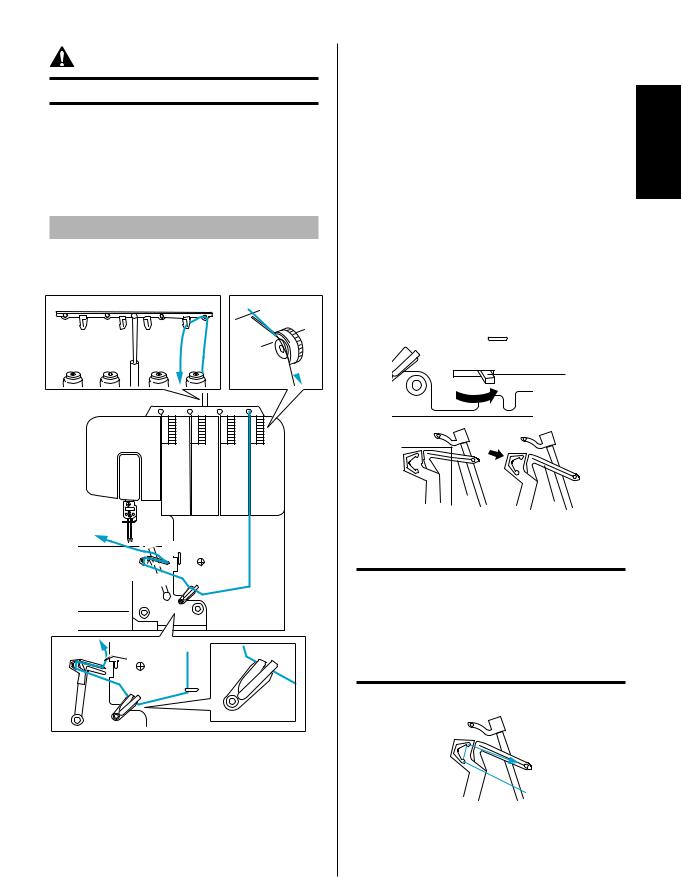
CHAPTER 3
THREADING
 CAUTION
CAUTION
Turn off the machine before threading for safety.
Threading has to be done in the following order.
1.Lower looper
2.Upper looper
3.Right needle
4.Left needle
Threading the lower looper
Run the thread in the sequence illustrated, following the blue color and the numbers next to each threading point.
1  3
3
2
4 
3
4
5
 0 9
0 9

 87
87 
 6
6
0 
9 
 87
87  6
6
1.Open the front cover by sliding to the right and guiding the top toward you.
2.Pull the thread off the spool and directly up through the thread holder 1 and the thread plate 2 on the thread tree from back to front.
3.Pass the thread thourgh the hole 3 on the top of machine.
4.Pass the thread through the tension disc 4 which is in the channel next to the blue tension adjustment dial.
5.Guide the thread down the channel and
pass the thread through the threading points |
|
|
5678 next to the blue color marks following |
English |
|
the numerical order in the accompanying |
||
|
||
illustration. |
|
|
NOTE: |
|
|
Make sure to thread both of the thread take ups 7. |
|
|
Continue on "Lower looper easy threading |
|
|
|
||
operation". |
|
Lower looper easy threading operation
1.Slide the lower looper threading lever <A> to the right.
The lower looper <B> moves to the position illustrated as below.
<A>
<B> |
<B> |
|
 CAUTION
CAUTION
Slide the threading lever only in the directions shown by the arrow. Forcefully moving the threading lever in any other direction may damage it.
Before sliding the lower looper threading lever, make sure the needle is at its highest position.
2. Pass the thread as illustrated.
15
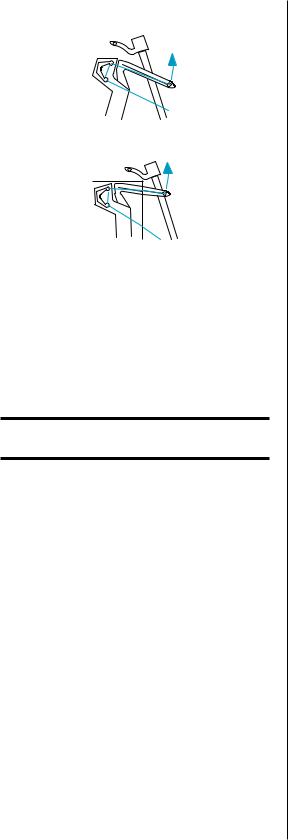
3.Pass the thread through the eye of the lower looper.
4.Slowly turn the hand wheel, and make sure the returns to the original position.
NOTE:
If the lower looper thread breaks during sewing, cut and remove thread from both of the needles.
Before re-threading the lower looper, make sure that the lower looper re-threading is done exactly as diagrammed. The machine will not operate properly if the threading is not done in the proper sequence.
 CAUTION
CAUTION
Thread the needles after the lower looper and upper looper have been threaded.
16
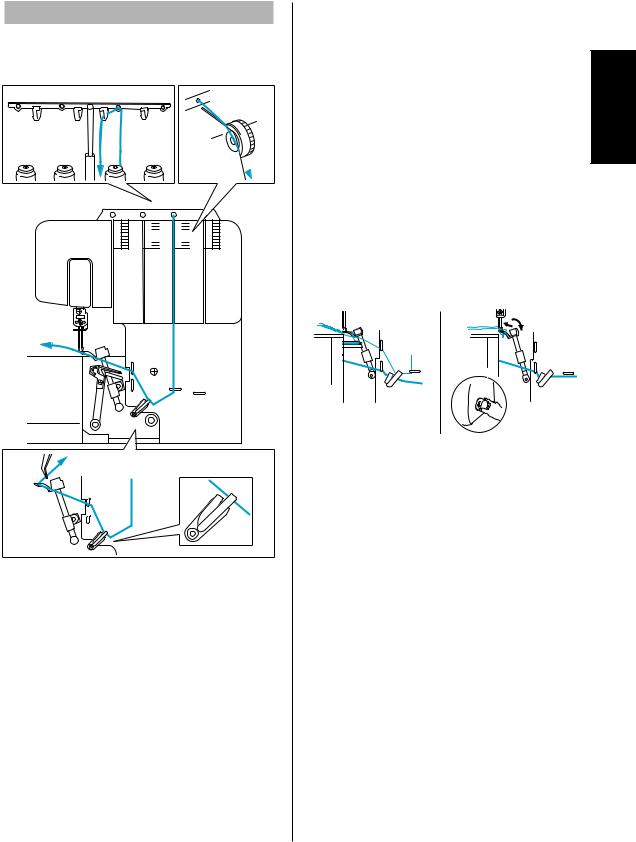
Threading the upper looper
Run the thread in the sequence illustrated, following the green color and the numbers next to each threading point.
1 |
3 |
|
2
4 

 3
3


 4
4 

5
9
8
7 6
9 8
6
7 
1.Open the front cover by sliding to the right and guiding the top toward you.
2.Pull the thread off the spool and directly up through the thread holder 1 and the thread plate 2 on the thread tree from back to front.
3.Pass the thread thourgh the hole 3 on the top of machine.
4.Pass the thread through the tension disc 4 which is in the channel next to the green tension adjustment dial.
5.Guide the thread down the channel and pass the thread through the threading points 5678 next to the green color marks following the numerical order in the accompanying illustration.
NOTE:
Make sure to thread only through the upper thread take up 7.
6.Pass the thread through the eye of the upper looper 9.
NOTE:
If the upper looper thread breaks during sewing: This may be caused by the lower looper thread getting caught on the upper looper. If this happens, lower the upperlooper by turning the hand wheel, remove the lower looper thread from the upper looper, and re-thread the upper looper from at least the tension disc.
English
17
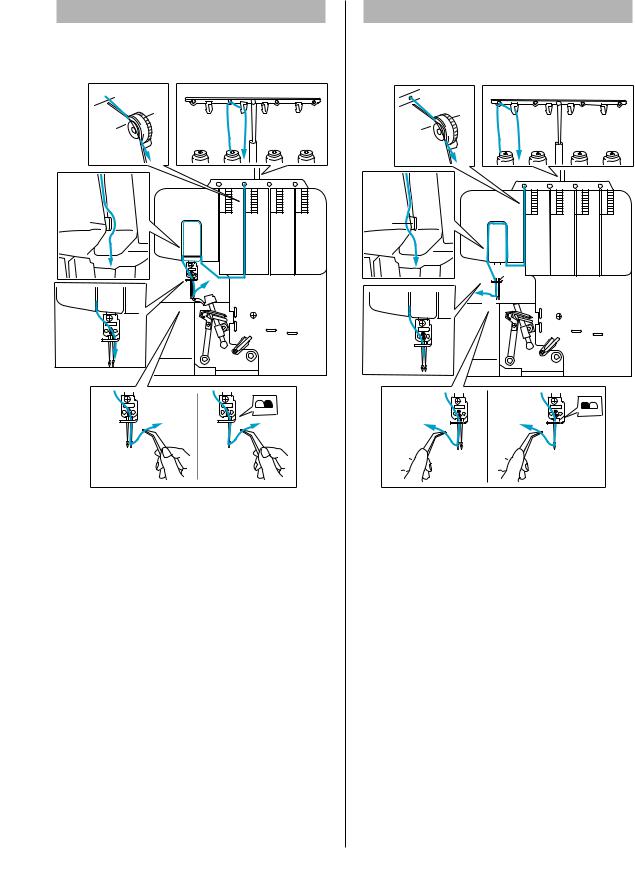
Threading the right needle
Run the thread in the sequence illustrated below, following the pink color and the numbers next to each threading point.
 3 1
3 1
|
|
2 |
|
4 |
|
|
|
3 |
<A> |
|
4 |
|
|
6 |
|
7 |
5 |
|
|
|
|
|
8 |
7
8 8
<B> |
<C> |
1.Pull the thread off the spool and directly up through the thread holder 1 and the thread plate 2 on the thread tree from back to front.
2.Pass the thread thourgh the hole 3 on the top of machine.
3.Pass the thread through the tension disc 4 which is in the channel next to the pink tension adjustment dial.
4.Guide the thread down the channel and across through the threading points 5 6 7 next to the pink color marks following the numerical order in the accompanying illustration.
NOTE:
Make sure the thread is through the right of the separater <A>.
5.Bring the thread down through the needle bar thread guide and through the right needle 8 from front to back.
(<B>: two needles/ <C>: one needle)
Threading the left needle
Run the thread in the sequence illustrated, following the yellow color and the numbers next to each threading point.
|
3 |
1 |
|
|
|
|
|
2 |
|
4 |
|
|
|
3 |
<A> |
|
4 |
 6 7
6 7 5
5
8
7 
<B> |
<C> |
 8
8  8
8
1.Pull the thread off the spool and directly up through the thread holder 1 and the thread plate 2 on the thread tree from back to front.
2.Pass the thread thourgh the hole 3 on the top of machine.
3.Pass the thread through the tension disc 4 which is in the channel next to the yellow tension adjustment dial.
4.Guide the thread down the channel and across through the threading points 5 6 7 next to the yellow color marks following the numerical order in the accompanying illustration.
NOTE:
Make sure the thread is through the left of the separater <A>.
5.Bring the thread down through the needle bar thread guide and through the left needle 8 from front to back.
(<B>: two needles/ <C>: one needle)
18

CHAPTER 4
SEWING MATERIALS,THREADS AND NEEDLES COMPARISON CHART
Material |
Stitch |
Stitch Length |
Thread |
Needle |
|
(mm) |
|||||
|
|
|
|
||
|
|
|
|
|
|
Fine materials: |
Overlock stitch |
2.0-3.0 |
Spun #80-90 |
130/705H |
|
Georgette |
|
|
Cotton #100 |
#80 |
|
Lawn |
|
|
Tetron #80-100 |
|
|
Organdy |
|
|
|
|
|
Tricot |
|
|
|
|
|
|
|
|
|
|
|
Fine materials: |
Narrow over lock/ |
R-2.0 |
Needle thread : |
130/705H |
|
Georgette |
Rolled hemming |
|
Spun #80-90 |
#80 |
|
Lawn |
stitch |
|
Tetron #80-100 |
|
|
Organdy |
|
|
|
|
|
Tricot |
|
|
Looper thread : |
|
|
|
|
|
Woolly nylon thread |
|
|
|
|
|
Spun #80-90 |
|
|
|
|
|
Tetron #80-100 |
|
|
|
|
|
|
|
|
Medium materials: |
Overlock stitch |
2.5-3.5 |
Spun #60-80 |
130/705H |
|
Broad cloth |
|
|
Cotton #60-80 |
#80 |
|
Gabardine |
|
|
Tetron #60-80 |
#90 |
|
Serge |
|
|
|
|
|
|
|
|
|
|
|
Medium materials: |
Narrow over lock/ |
R-2.0 |
Needle thread : |
130/705H |
|
Broad cloth |
Rolled hemming |
|
Spun #60-80 |
#80 |
|
|
stitch |
|
Tetron #60-80 |
#90 |
|
|
|
|
Looper thread : |
|
|
|
|
|
Woolly nylon thread |
|
|
|
|
|
Spun #60-80 |
|
|
|
|
|
Tetron #60-80 |
|
|
|
|
|
|
|
|
Heavy materials: |
Overlock stitch |
3.0-4.0 |
Cotton #50-60 |
130/705H |
|
Tweed |
|
|
Spun #60 |
#90 |
|
Denim |
|
|
Tetron #50-60 |
|
|
Knits |
|
|
|
|
|
|
|
|
|
|
|
NOTE: |
|
|
|
|
Decorative thread will work best in the upper looper for fashion sewing.
English
19
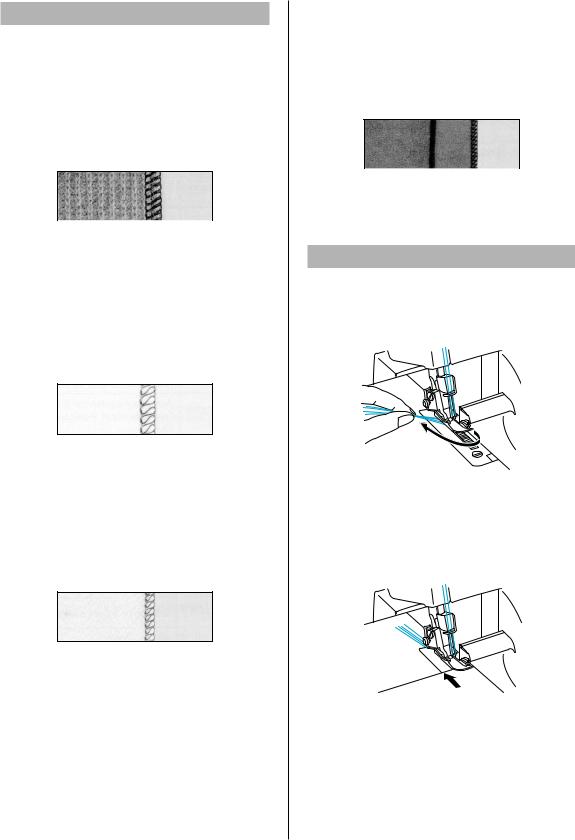
CHAPTER 5 SEWING
Stitch selection
Select the stitch pattern before you start sewing. This sewing machine can sew five different stitches by following the simple steps below:
Four-thread overlock stitch
Use all four threads and two needles for producing four-thread overlock stitches.
Use: Produces strong seam. Ideal for sewing knits and wovens.
Three-thread overlock stitch 5 mm (3/16 inch)
Use three threads and the left needle, producing 5 mm (3/16 inch) seams.
Use: For overlock stitching on suits, blouses, slacks, etc. Ideal for medium to heavy materials.
NOTE:
Remove the right needle when sewing this overlock stitch.
Three-thread overlock stitch 2.8 mm (7/64 inch)
Use three threads and the right needle, producing 2.8 mm (7/64 inch) seams.
Use: For overlock stitching on suits, blouses, slacks, etc. Ideal for fi ne to medium materials.
NOTE:
Remove the left needle when sewing this overlock stitch.
Narrow overlock stitch 2.0mm (5/64 inch) and
Rolled hemming stitch 2.0mm (5/64 inch)
Use as decorative or fi nishing stitch. See "Narrow overlock/ Rolled hemming stitch" in this chapter for details.
NOTE:
You can use the optional accessory foot for even more varieties of stitches. See CHAPTER 8 for details.
Test sewing
Test-sew before you start sewing.
1.Set all the thread tension to "4".
2.Thread the machine and pull all threads out about 15 cm (6 inches) behind the presser foot.
3.Place a piece of scrap material under the presser foot for test sewing.
NOTE:
Always lift the presser foot before placing the fabric under it. You cannot start sewing by just running the fabric under the foot without lifting the presser foot.
20
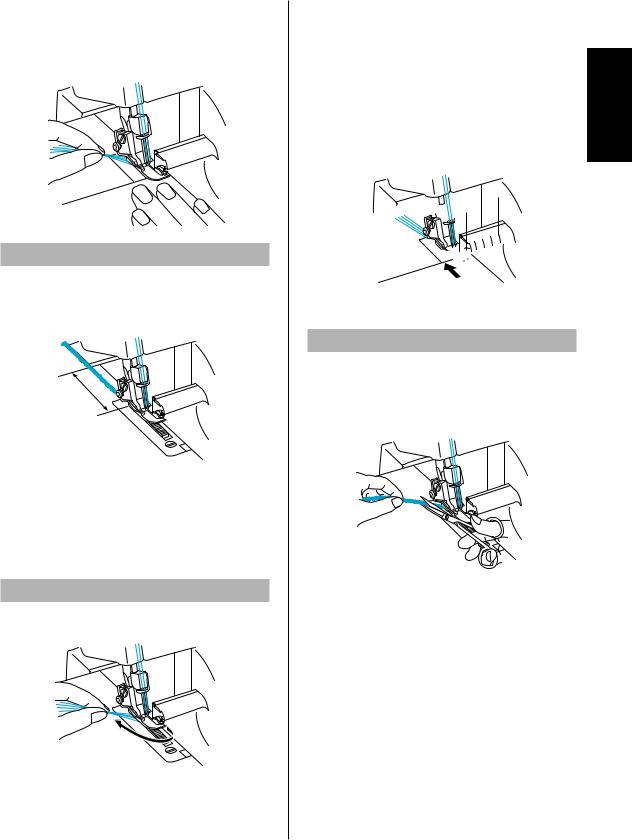
4.Holding all threads with your left hand, turn the hand wheel slowly a few times toward you, and check to see that the threads entwine themselves before using the foot controller to sew.
Chaining-off
After test-sewing, continue to depress the foot controller slightly and chain off 10 cm (4 inches). The threads will entwine themselves into a chain automatically.
NOTE:
If the thread tension is not correctly balanced, the chaining-off result will be uneven. If this happens, pull the threads slightly. Check the threading order and adjust the thread tension to create an even chain. (See CHAPTER 1 "Tension adjustment dial".)
To start sewing
1.Thread the machine and pull all threads out about 15 cm (6 inches) behind the presser foot.
2.Lift the presser foot and place the material well underneath the presser foot before starting to sew. Slowly sew a few stitches by turning the hand wheel.
3.The fabric will be fed automatically. You need only guide it in the required direction.
4.Check the stitch formation (stitch chain) to see if it is uniform. If the stitch is not uniform, re-check that the threading has been done properly and in sequence.
5.Follow the Seam Allowance Guide for consistent cutting of the fabric seams. The scale of Seam Allowance Guide shows 9.5, 12.7, 15.9, and 25.4 mm (3/8, 1/2, 5/8, and 1 inches) when the stitch width dial is set to "5".
3


 2
2
1 



1 Presser foot 2 Upper knife 3 Seam Allowance Guide
To remove work
When the seam is fi nished, keep the machine running at a low speed to obtain chaining-off. Then cut the stitches 5 cm (2 inches) from the work.
If feeding for chaining-off is not enough, pull the thread gently.
English
21
